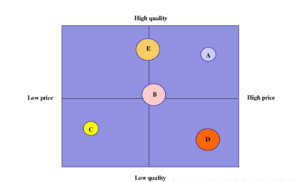Positioning
In marketing, Positioning is the process by which marketers try to create an image or identity in the minds of their target market for its product, brand, or organization. Re-positioning involves changing the identity of a product, relative to the identity of competing products. De-positioning involves attempting to change the identity of competing products, relative to the identity of your own product. The original work on positioning was consumer marketing oriented, and was not as much focused on the question relative to competitive products as on cutting through the ambient noise and establishing a moment of real contact with the intended recipient.
The growth of high-tech marketing may have had much to do with the shift in definition towards competitive positioning. An important component of hi-tech marketing in the age of the world wide web is positioning in major search engines such as Google, Yahoo and Bing, which can be accomplished through Search Engine Optimization, also known as SEO. This is an especially important component when attempting to improve competitive positioning among a younger demographic, which tends to be Web oriented in their shopping and purchasing habits as a result of being highly connected and involved in social media in general.
Brand positioning process
Effective Brand Positioning is contingent upon identifying and communicating a brand's uniqueness, differentiation and verifiable value. It is important to note that me too brand positioning contradicts the notion of differentiation and should be avoided at all costs. This type of copy act brand positioning only works if the business offers its solutions at a significant discount over the other competitor(s). Generally, the brand positioning process involves:
- Identifying the business's direct competition
- Understanding how each competitor is positioning their business today
- Documenting the provider's own positioning as it exists today
- Comparing the company's positioning to its competitors' to identify viable areas for differentiation
- Developing a distinctive, differentiating and value-based positioning concept
- Creating a positioning statement with key messages and customer value propositions to be used for communications development across the variety of target audience touch points
Product positioning process
Generally, the product positioning process involves:
- Defining the market in which the product or brand will compete
- Identifying the attributes that define the product space
- Collecting information from a sample of customers about their perceptions of each product on the relevant attributes
- Determine each product's share of mind
- Determine each product's current location in the product space
- Determine the target market's preferred combination of attributes
- Examine the fit between the product and the market.
Measuring the positioning
Positioning is facilitated by a graphical technique called perceptual mapping, various survey techniques, and statistical techniques like multi dimensional scaling, factor analysis, conjoint analysis, and logit analysis.
Repositioning a company
In volatile markets, it can be necessary - even urgent - to reposition an entire company, rather than just a product line or brand. When Goldman Sachs and Morgan Stanley suddenly shifted from investment to commercial banks, for example, the expectations of investors, employees, clients and regulators all needed to shift, and each company needed to influence how these perceptions changed. Doing so involves repositioning the entire firm. This is especially true of small and medium-sized firms, many of which often lack strong brands for individual product lines. In a prolonged recession, business approaches that were effective during healthy economies often become ineffective and it becomes necessary to change a firm's positioning. Upscale restaurants, for example, which previously flourished on expense account dinners and corporate events, may for the first time need to stress value as a sale tool.
Repositioning a company involves more than a marketing challenge. It involves making hard decisions about how a market is shifting and how a firm's competitors will react. Often these decisions must be made without the benefit of sufficient information, simply because the definition of volatility is that change becomes difficult or impossible to predict. Positioning is however difficult to measure, in the sense that customer perception on a product may not tested on quantitative measures.
